Zen meditation practices offer a pathway to cultivate inner peace and presence by enhancing mindfulness and reducing stress. These techniques include seated meditation, mindful breathing, and koan contemplation, each providing unique benefits. Regular practice supports emotional regulation and helps overcome common challenges like distractions and inconsistent routines. Additionally, integrating Zen principles into daily life promotes a deeper connection to the present moment.
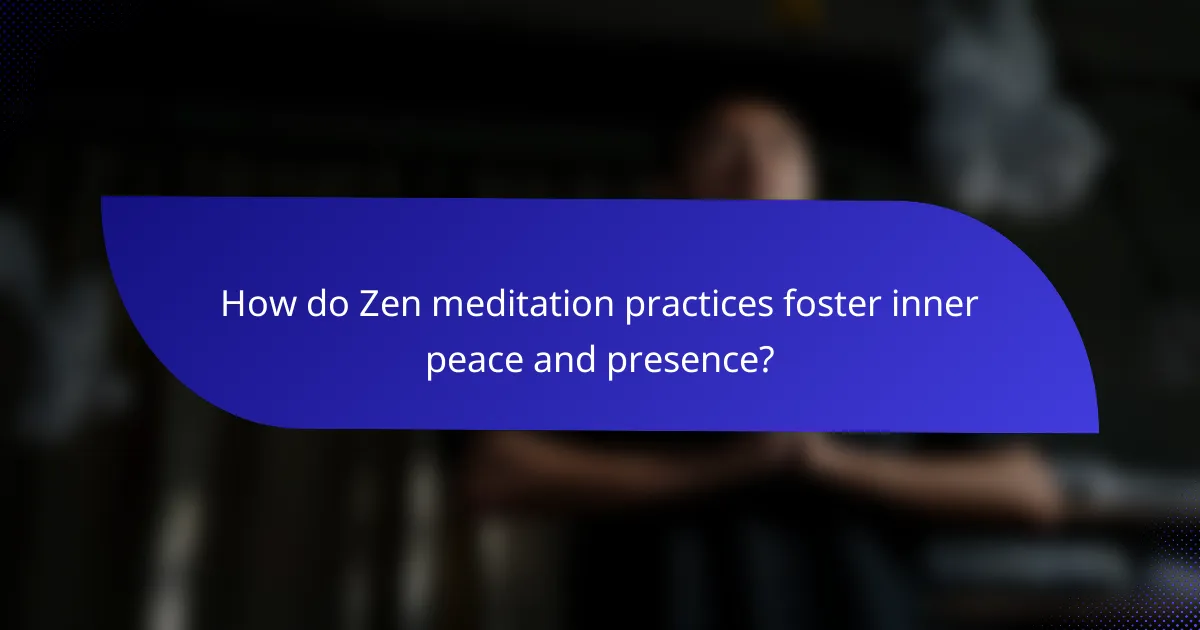
How do Zen meditation practices foster inner peace and presence?
Zen meditation practices cultivate inner peace and presence by promoting mindfulness and reducing stress. These techniques encourage individuals to focus on the present moment, fostering a deeper connection with their thoughts and feelings.
Regular practice enhances emotional regulation, allowing practitioners to respond to stressors with calmness. This emotional stability is rooted in the unique attribute of Zen meditation, which emphasizes awareness without judgment.
Moreover, studies indicate that consistent engagement in Zen practices can lead to measurable reductions in anxiety and depression symptoms. As a result, individuals often experience an increased sense of well-being and clarity.
In summary, Zen meditation serves as a powerful tool for achieving inner peace and presence through mindfulness, emotional regulation, and stress reduction.
What are the foundational principles of Zen meditation?
The foundational principles of Zen meditation include mindfulness, breath awareness, and the practice of letting go. These principles cultivate inner peace and presence by encouraging individuals to focus on the present moment. Mindfulness promotes awareness of thoughts and feelings without judgment. Breath awareness anchors the mind, providing a focal point for meditation. Letting go involves releasing attachments and distractions, fostering a state of calm. Together, these principles create a holistic approach to achieving tranquility and clarity in daily life.
Why is breath awareness essential in Zen meditation?
Breath awareness is essential in Zen meditation as it anchors the mind and cultivates presence. Focusing on breath helps practitioners develop mindfulness, reducing distractions and enhancing inner peace. This practice deepens the connection to the present moment, allowing for greater emotional regulation and clarity. Regular breath awareness can lead to profound insights and a unique sense of tranquility, making it a cornerstone of Zen meditation.
How does mindfulness enhance the Zen meditation experience?
Mindfulness significantly enhances the Zen meditation experience by deepening focus and presence. It fosters greater awareness of thoughts and sensations, allowing practitioners to engage fully in the moment. This heightened state of awareness promotes relaxation and reduces stress, contributing to a more profound sense of inner peace. Mindfulness practices in Zen meditation can lead to improved emotional regulation and clarity of thought, enhancing overall well-being. By integrating mindfulness, practitioners often report a more fulfilling and transformative meditation journey.
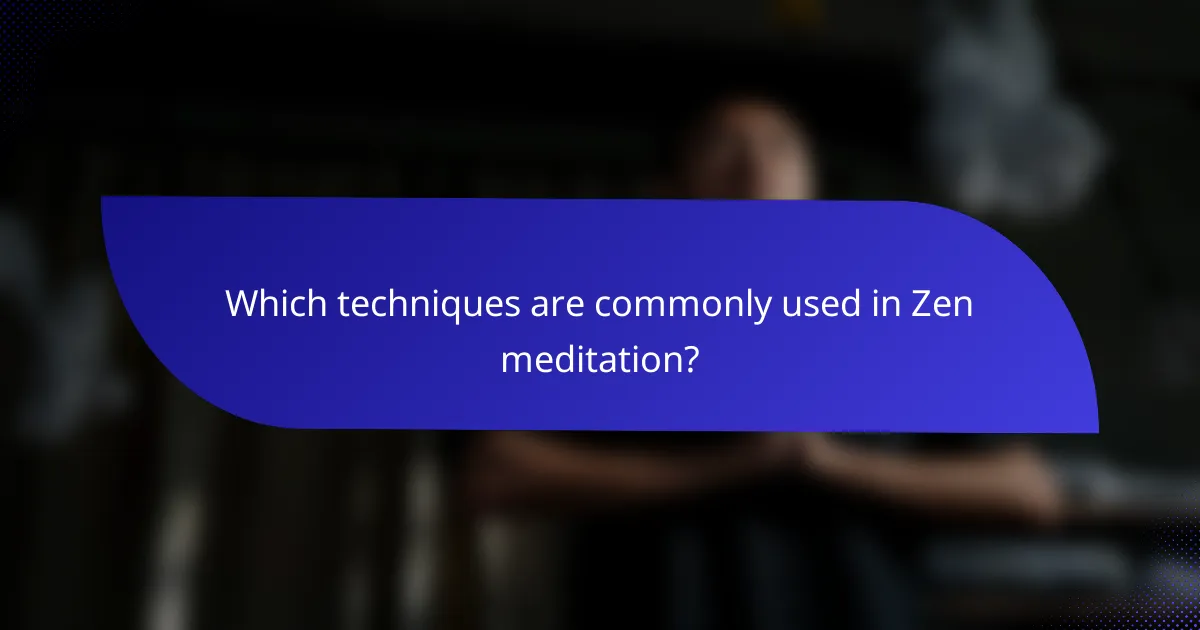
Which techniques are commonly used in Zen meditation?
Zen meditation commonly employs techniques such as seated meditation, mindful breathing, and koan contemplation. These methods help cultivate inner peace and enhance present-moment awareness. Seated meditation, or zazen, focuses on posture and breath, grounding practitioners in the moment. Mindful breathing emphasizes awareness of each inhalation and exhalation, fostering relaxation. Koan contemplation involves pondering paradoxical questions to transcend logical thinking, deepening insight. Each technique offers unique pathways to achieve tranquility and mindfulness.
What role does zazen play in Zen meditation practices?
Zazen plays a crucial role in Zen meditation practices by fostering deep awareness and presence. This seated meditation technique emphasizes stillness and mindfulness, allowing practitioners to cultivate inner peace. Through focused breathing and posture, zazen helps individuals connect with their thoughts and emotions, promoting clarity and insight. Regular practice of zazen can lead to transformative experiences, enhancing overall well-being and emotional resilience.
How can walking meditation deepen one’s practice?
Walking meditation deepens one’s practice by fostering mindfulness and enhancing present-moment awareness. This practice allows individuals to connect with their surroundings, cultivating a sense of calm and focus. The rhythmic nature of walking promotes a meditative state, making it easier to release distractions. Moreover, it integrates physical movement with mental clarity, enriching the overall meditation experience. Engaging in walking meditation regularly can lead to improved emotional balance and a deeper understanding of one’s thoughts and feelings.
What are the benefits of incorporating chanting in Zen meditation?
Incorporating chanting in Zen meditation enhances focus, deepens relaxation, and fosters a sense of community. Chanting serves as an anchor, helping practitioners maintain presence and cultivate inner peace. The rhythmic repetition of sounds can reduce stress and promote mindfulness, creating a powerful meditative experience. Additionally, collective chanting can strengthen social bonds among participants, enriching the overall practice.
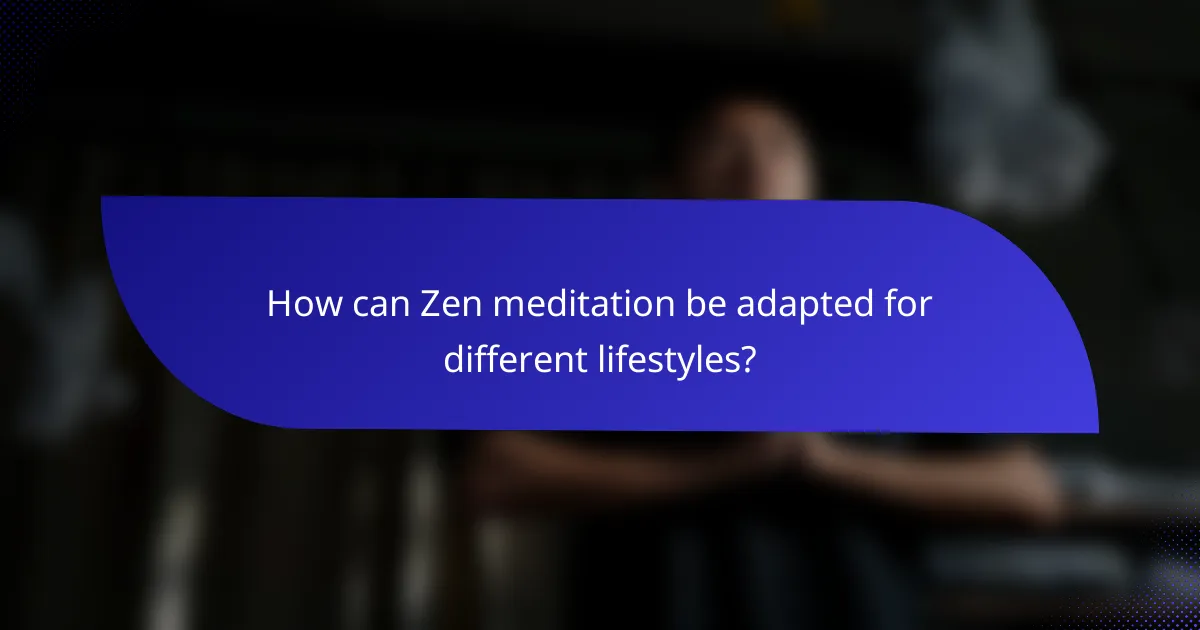
How can Zen meditation be adapted for different lifestyles?
Zen meditation can be adapted to various lifestyles by integrating short practices, flexible schedules, and mindful moments throughout the day. Busy individuals can benefit from brief sessions, such as five-minute mindfulness breaks, while those with more time can engage in longer meditative practices.
Incorporating Zen principles into daily activities, like mindful walking or eating, allows for a deeper connection to the present moment. For example, focusing on breath during routine tasks can enhance awareness and tranquility.
Moreover, technology can support adaptation. Meditation apps offer guided sessions that cater to different time constraints and preferences. This flexibility ensures that Zen meditation remains accessible, promoting inner peace regardless of lifestyle.
Ultimately, the key is to find a balance that fits personal schedules while fostering a consistent practice that cultivates presence and calm.
What approaches work best for busy professionals?
Zen meditation practices that fit busy professionals include short sessions, mindful breathing, and guided meditations. These approaches promote inner peace and presence without requiring extensive time commitments.
1. Short Sessions: Practicing for just 5-10 minutes can reduce stress and enhance focus.
2. Mindful Breathing: Focusing on breath for a few moments throughout the day helps ground attention.
3. Guided Meditations: Using apps or recordings allows for structured practice, making it easier to integrate into a busy schedule.
These methods cater to the unique challenges faced by professionals, offering flexibility and effectiveness.
Which practices are suitable for beginners?
Zen meditation practices suitable for beginners include breath awareness, body scan, and mindful walking. These practices foster inner peace and enhance present-moment awareness.
Breath awareness focuses on observing the natural rhythm of breathing, promoting relaxation. Body scan involves mentally scanning the body for tension, encouraging physical and mental release. Mindful walking combines movement with awareness, grounding practitioners in the present.
Each practice is accessible, requiring minimal setup and fostering a deeper connection to oneself. Beginners can gradually explore these techniques to cultivate a consistent meditation routine.
How can Zen meditation benefit students and academic environments?
Zen meditation significantly benefits students and academic environments by enhancing focus, reducing stress, and promoting emotional well-being. These practices foster a calm and present mindset, essential for effective learning.
Research indicates that regular Zen meditation can improve attention span and cognitive flexibility, which are crucial for academic success. A study found that students who practiced mindfulness techniques experienced a 30% increase in concentration levels.
Moreover, Zen meditation cultivates resilience against academic pressures. Students report lower anxiety and improved emotional regulation, creating a more positive learning atmosphere. This emotional stability allows for better collaboration and communication among peers.
Incorporating Zen meditation into academic settings can lead to a more harmonious environment, where students thrive both personally and academically.
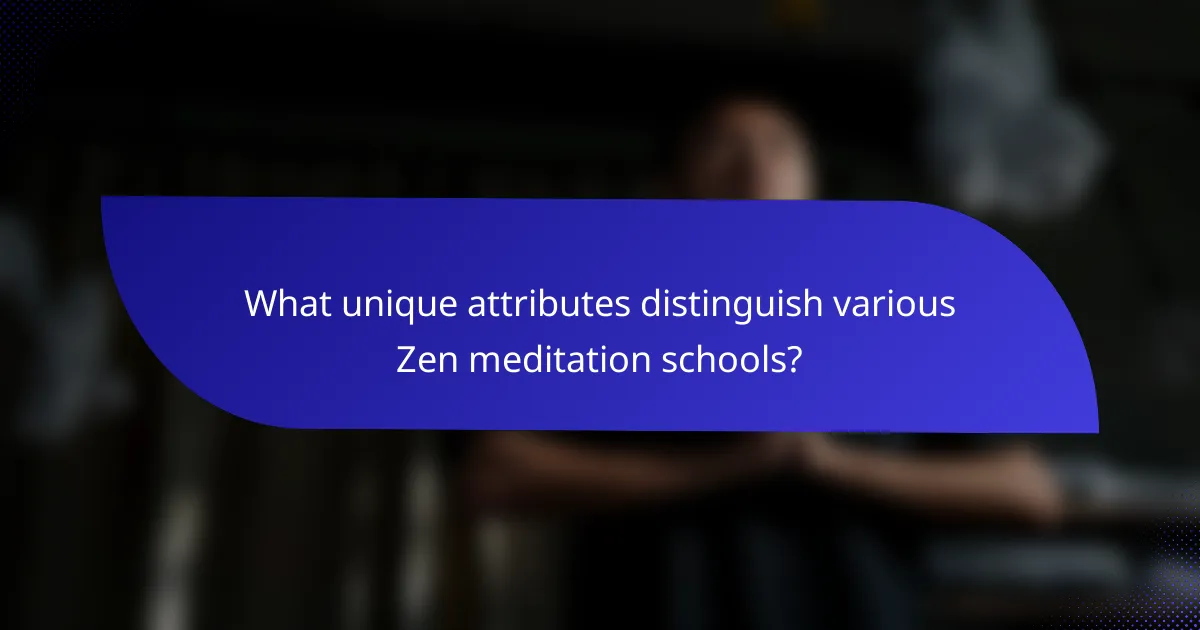
What unique attributes distinguish various Zen meditation schools?
Various Zen meditation schools are distinguished by their unique approaches and teachings. For example, the Soto school emphasizes shikantaza, or “just sitting,” focusing on the simplicity of being present. In contrast, the Rinzai school prioritizes koan practice, using paradoxical questions to provoke deep insight. The Obaku school blends elements from both Soto and Rinzai, incorporating chanting and rituals. Each school’s unique attributes shape the practitioners’ experiences and understanding of Zen meditation, contributing to a diverse landscape of practices aimed at cultivating inner peace.
How does the Rinzai school approach Zen meditation differently?
The Rinzai school emphasizes koan practice in Zen meditation, distinguishing it from other approaches. This method involves engaging with paradoxical questions or statements to provoke deep introspection and insight. Rinzai practitioners often experience intense, focused sessions aimed at breaking conventional thought patterns. This unique attribute fosters sudden enlightenment moments, known as “satori.” In contrast, other Zen schools may prioritize breath awareness or shikantaza, which focuses on just sitting. The Rinzai approach cultivates a dynamic, interactive meditation experience, promoting rapid personal transformation.
What are the key differences between Soto and Obaku Zen practices?
Soto and Obaku Zen practices differ primarily in their approach to meditation and teachings. Soto emphasizes Shikantaza, or “just sitting,” focusing on the experience of meditation itself without specific goals. Obaku, influenced by Chinese traditions, incorporates chanting and a more structured practice, blending seated meditation with devotional elements. Soto values simplicity and direct experience, while Obaku integrates ritual and community engagement. Both aim to cultivate inner peace and presence but through distinct methodologies.
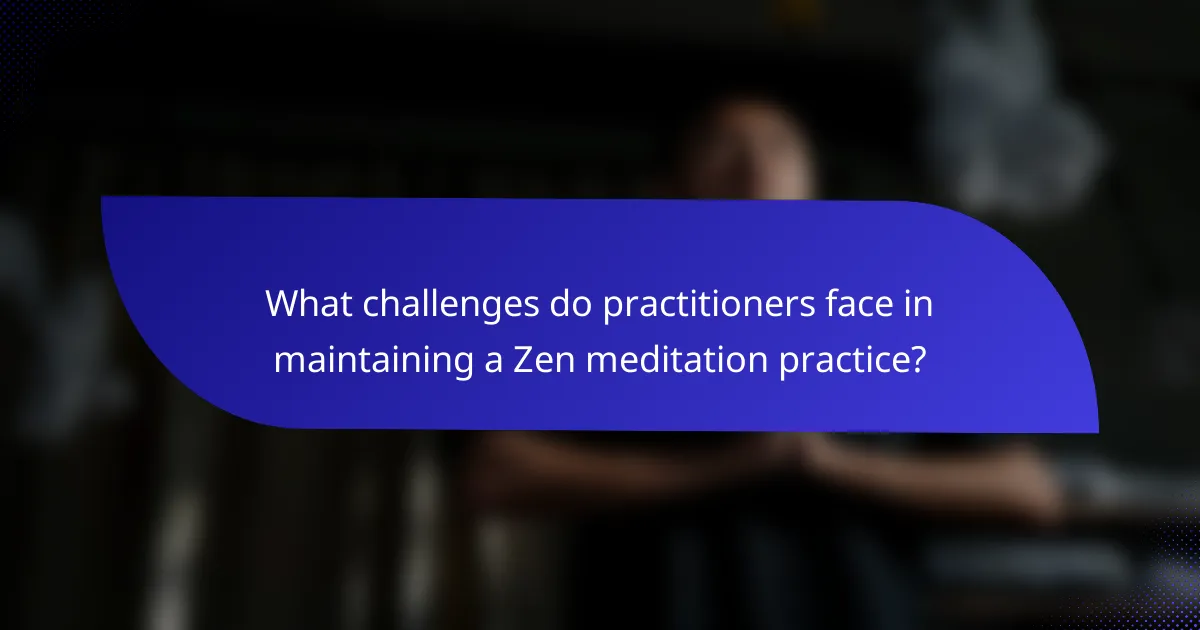
What challenges do practitioners face in maintaining a Zen meditation practice?
Practitioners face various challenges in maintaining a Zen meditation practice, including distractions, inconsistent routines, and emotional resistance. These obstacles can hinder the cultivation of inner peace and presence.
Distractions often arise from external environments and internal thoughts, making it difficult to focus. A lack of a consistent meditation routine can lead to irregular practice, diminishing the benefits over time. Emotional resistance may manifest as discomfort with stillness, creating barriers to deepening the meditation experience.
Developing strategies to overcome these challenges is essential for sustaining a committed practice and achieving the desired state of mindfulness.
How can distractions be managed during meditation sessions?
Distractions during meditation can be effectively managed by creating a conducive environment and using specific techniques. Establish a quiet space free from interruptions. Focus on your breath to anchor your mind. Acknowledge distractions without judgment, then gently redirect your attention. Incorporate mindfulness techniques to enhance present-moment awareness. Regular practice strengthens concentration, making it easier to remain focused over time.
What strategies help overcome physical discomfort while meditating?
To overcome physical discomfort while meditating, focus on posture, breathing, and gradual adaptation. Proper alignment reduces strain and enhances comfort. Mindful breathing helps relieve tension and cultivates awareness of discomfort. Gradually increasing meditation duration allows the body to adapt, minimizing discomfort over time.
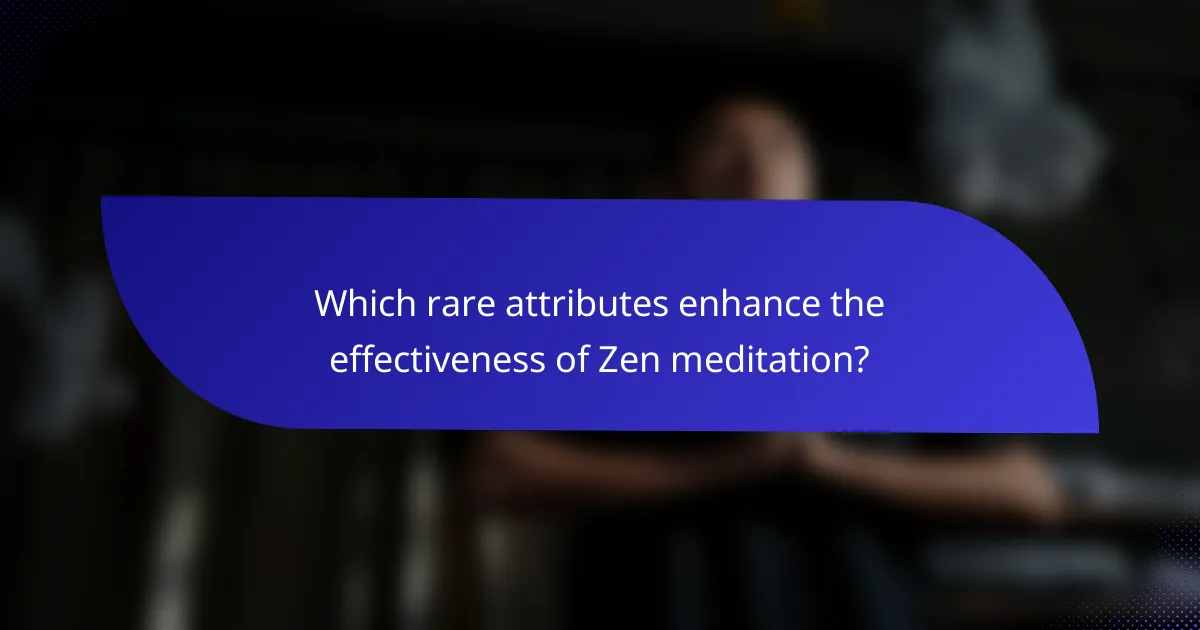
Which rare attributes enhance the effectiveness of Zen meditation?
Rare attributes that enhance the effectiveness of Zen meditation include sensory awareness, non-attachment to outcomes, and deep emotional resonance. These traits foster a profound connection to the present moment, allowing practitioners to cultivate inner peace. Sensory awareness heightens the experience of meditation, making each moment more vivid. Non-attachment encourages a release from expectations, reducing stress and enhancing focus. Deep emotional resonance facilitates a greater understanding of one’s thoughts and feelings, promoting emotional balance. Together, these rare attributes significantly amplify the benefits of Zen meditation practices.
How does the integration of nature impact Zen meditation practices?
The integration of nature enhances Zen meditation practices by fostering a deeper connection to the present moment. Natural environments reduce stress and promote tranquility, allowing practitioners to cultivate inner peace. Studies show that exposure to greenery can improve focus and emotional well-being. Additionally, practicing meditation outdoors can create a unique sensory experience, enriching mindfulness and awareness.
What role does community play in deepening Zen meditation experiences?
Community significantly enhances Zen meditation experiences by fostering connection and support. Engaging with others in practice deepens commitment and accountability, allowing individuals to share insights and challenges. This collective experience cultivates a sense of belonging, which can amplify inner peace and mindfulness. Additionally, group meditation sessions often create a heightened energy that can enhance individual practice, making the experience more profound. Regular interaction within a community also provides opportunities for learning from diverse perspectives, enriching one’s understanding of Zen principles.
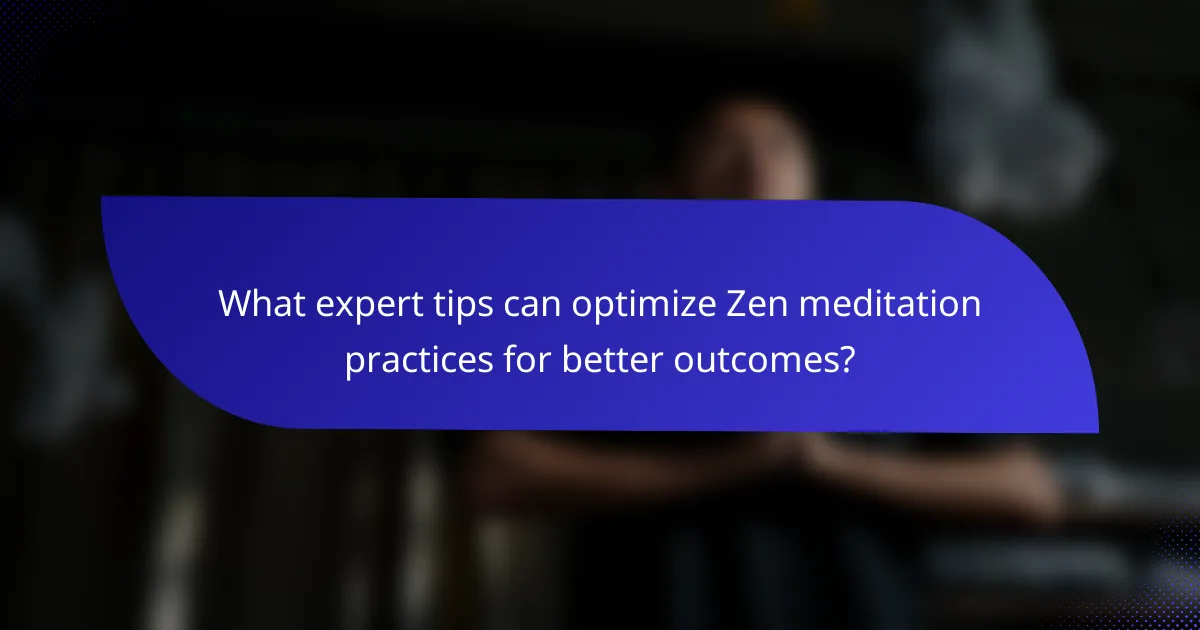
What expert tips can optimize Zen meditation practices for better outcomes?
To optimize Zen meditation practices for better outcomes, focus on consistency, environment, and mindfulness techniques. Establish a regular schedule to create a habit. Choose a quiet, comfortable space free from distractions to enhance focus. Incorporate mindfulness techniques, such as breath awareness or body scanning, to deepen the meditative experience. These strategies cultivate inner peace and presence effectively.
How can setting intentions improve meditation sessions?
Setting intentions can significantly enhance meditation sessions by providing focus and clarity. Intentions act as guiding principles, helping practitioners remain anchored during their practice. This mindfulness cultivates a deeper connection to the present moment, fostering inner peace. Research indicates that individuals who set intentions report greater satisfaction and effectiveness in their meditation experiences. By aligning thoughts and actions, intentions create a purposeful framework, allowing for more profound insights and emotional release during Zen meditation practices.
What common mistakes should be avoided in Zen meditation?
To enhance Zen meditation, avoid common mistakes that disrupt focus and presence. Key errors include forcing a specific mindset, neglecting posture, and allowing distractions. Additionally, practicing for too long without breaks can lead to discomfort and frustration. Embrace a relaxed approach, prioritize comfort, and maintain awareness of your surroundings.
How can maintaining a consistent schedule enhance practice effectiveness?
Maintaining a consistent schedule enhances practice effectiveness by establishing a routine that fosters discipline and focus. Consistency in Zen meditation allows practitioners to deepen their experience of inner peace and presence. Regular practice helps to reinforce mindfulness, making it easier to enter a meditative state. As a result, practitioners often report increased clarity and emotional stability over time. This structured approach not only maximizes the benefits of meditation but also cultivates a lasting sense of calm and awareness in daily life.